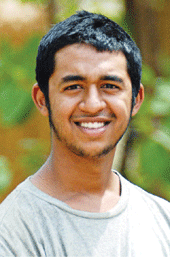 Switching to a new pedagogy enabled Mumbai-based Akansha Sarda to transform her aversion to physics into an affinity for the subject. Three years ago, as a school student she barely managed to pass the subject. Recently she became the second woman student to qualify for the International Physics Olympiad (IPhO). Together with four other team members, Akansha will represent India at the 41st annual IPhO to be held in Zagred, Croatia from July 17-25.
Switching to a new pedagogy enabled Mumbai-based Akansha Sarda to transform her aversion to physics into an affinity for the subject. Three years ago, as a school student she barely managed to pass the subject. Recently she became the second woman student to qualify for the International Physics Olympiad (IPhO). Together with four other team members, Akansha will represent India at the 41st annual IPhO to be held in Zagred, Croatia from July 17-25.
“In school, physics was taught like history — with a ‘this is what is’ pedagogy. My mother encouraged me not to give up and took me to attend a seminar at IITian’s Pace, a coaching institute. In the institute this wonderful and intellectually stimulating subject was taught in a logical and sequential manner, much like maths. That’s when I discovered my love for physics,” says Akansha.
Currently a class XII student of Mumbai’s Sathaye College, Akansha has been admitted into the prestigious Massachusetts Institute of Technology (MIT) to study science. Meanwhile she was one of the 36,000 students country-wide who applied to represent India in IPhO, 2010. After two rounds of written tests administered by the Homi Bhabha Centre for Science Education, Mumbai, she was included in the final shortlist of 35 — the only woman candidate.
Even if her teammates were surprised, Akansha herself was confident. A class X ICSE topper, she was among the top 20 of the 350,000 students who wrote IIT-JEE 2010, and was ranked first among women. “Although my parents encourage me to study, I have never been pressurised to perform. In fact, my parents often tell me to slow down my pace and lead a normal life,” she says. So she makes it a point to catch several movies a week, has a flair for French, reads fiction and indulges in healthy doses of retail therapy, like any teenage girl.
“The final stages of preparation for IPhO 2010 will be very rigorous,” says Prof. Vijay Singh, national coordinator for science olympiads. But he is confident that this year’s team from India will surpass China, whose students have been routinely topping the IPhO. “We have won four golds and one silver for a few years in a row. This year we will bag five golds,” he says assuredly.
But however the Indian team fares at IPhO 2010, Akansha is sure to continue breaking moulds and go places as a physicist.
Nisha Khiani (Mumbai)
Aamod Zambre
 Scorpions are likely to figure last on most favourite lists of God’s creations. But in 21-year-old Aamod Zambre’s book, these feared crawlies are top favourites. Not content with observing them at close quarters, this young zoology student has taken his singular interest to a higher level by creating an online photographic album, featuring the diverse species of the reclusive Indian scorpion. With over 45 of the 120-odd species found in India already catalogued, Aamod hopes to keep updating and enhancing his portfolio with additional members of the genus scorpio indicus.
Scorpions are likely to figure last on most favourite lists of God’s creations. But in 21-year-old Aamod Zambre’s book, these feared crawlies are top favourites. Not content with observing them at close quarters, this young zoology student has taken his singular interest to a higher level by creating an online photographic album, featuring the diverse species of the reclusive Indian scorpion. With over 45 of the 120-odd species found in India already catalogued, Aamod hopes to keep updating and enhancing his portfolio with additional members of the genus scorpio indicus.
Aamod’s interest in the arthropod dates back to the time when he was a class XII student of the Abhinav College, Pune. Already a wildlife enthusiast, he chanced upon a book by eminent zoologist D. B. Bastavade. “Though the book contained a plethora of information about scorpions, there were hardly any photographs. That’s because relatively few researchers have explored this species, especially scorpio indicus,” he says. “However, this cool creature, which has been around since the age of the dinosaurs and has hardly changed morphologically, has always intrigued me. It’s a great survivor and continues to thrive in diverse environ-ments, be it hot and dusty climes, rainforests or 3,500 metres above sea level in snowcapped mountains,” says Aamod.
This consuming interest has prom-pted Aamod to scour the subcontinent to discover this pincered creature, taking him from the backwaters of the river Mulshi in Pune to the desert of Rajasthan and wildlife sanctuaries of Arunachal Pradesh and Assam to film it in its natural environment. “It’s hard work and calls for great patience because you have to spend long hours to first spot a scorpion, and then track it to photograph it accurately. My only precaution is to use a pair of forceps. Handling a scorpion without that can be extremely dangerous,” warns Aamod.
However, such elementary precautions haven’t prevented him from being stung several times. “It hurts for a couple of hours, you just have to endure it,” he says.
Currently a B.Sc (zoology) student at Pune University, Aamod has posted images on www.indianscorpions. blogspot.com together with information about various species. On his agenda is proceeding for a Masters in zoology at the National Centre for Biological Sciences, Bangalore. “Hopefully, together with experienced researchers, I will be able to add 20 new members to the known list of Indian scorpions,” he says optimistically.
Use the forceps every time!
Huned Contractor (Pune)